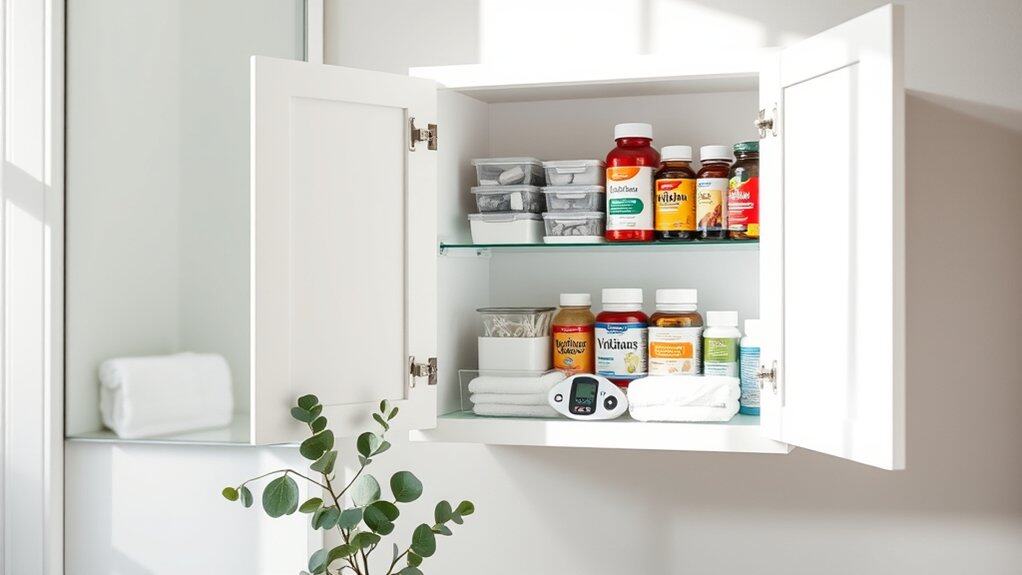Whether you’re reaching for daily vitamins or searching for bandages in an emergency, an organized medicine cabinet can save you precious time and unnecessary stress. I’ve learned firsthand that a messy cabinet isn’t just frustrating – it can actually be dangerous when you can’t quickly find what you need. You’ll be amazed at how these seven simple organization tips can transform your cabinet from chaos to calm, making your daily routine smoother and safer.
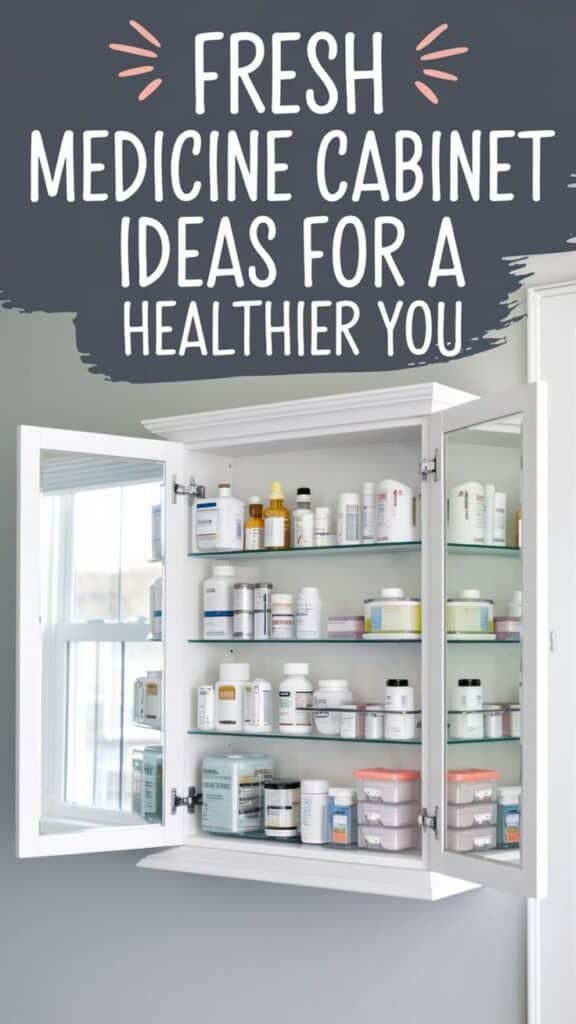
Sort and Discard Expired Items
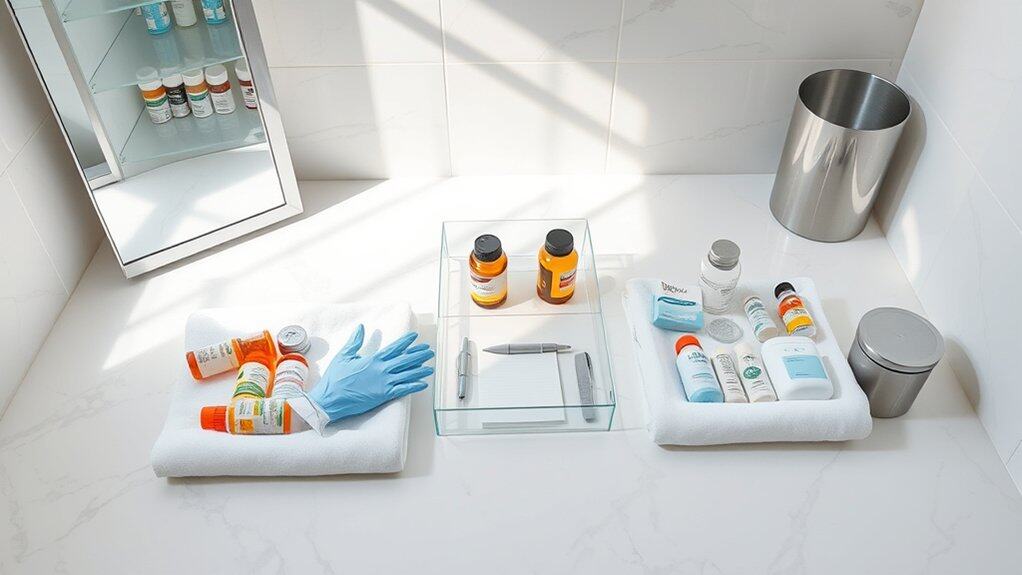
Keeping track of expired medications and personal care items is crucial for both safety and effectiveness. Expired medications can lose their potency or even become harmful, while outdated personal care products may harbor bacteria or lose their intended benefits. Regular maintenance of these items can prevent accidental usage of expired products and ensure you have space for essential, current items.
Organizing expired items in your medicine cabinet isn’t just about safety – it’s about creating an efficient system that allows you to quickly access what you need in an emergency. When you remove expired items regularly, you maintain a clear inventory of your medical supplies and can better track when replacements are needed.
Required Items:
- Large trash bag
- Small box for recyclable containers
- Paper and pen for inventory
- Rubber gloves
- Cleaning cloth
- Disinfectant spray
- Container for sorting items
- Permanent marker
Start by removing everything from your medicine cabinet and placing items on a clean, flat surface. Check every expiration date, including prescription medications, over-the-counter drugs, first aid supplies, and personal care products. Create three distinct piles: expired items, items expiring within six months, and items with distant expiration dates.
For prescription medications that are expired, follow proper disposal guidelines – many communities have specific medication disposal programs or take-back events. For other items, dispose of them according to package instructions.
When checking dates, pay special attention to items that don’t have clear expiration dates. As a general rule, most liquid medications should be discarded after one year, while solid medications typically last between two to three years. For personal care items like sunscreen, cosmetics, and first aid supplies, mark the date opened on the container and follow industry guidelines for shelf life.
Additional Tip: Create a running inventory list of items with their expiration dates, and set calendar reminders for products that will expire within six months. Place newer items toward the back of the cabinet and older items in front to maintain a first-in, first-out system. This practice ensures you use products before they expire and helps maintain an organized, safe medicine cabinet year-round.
Create Designated Storage Zones
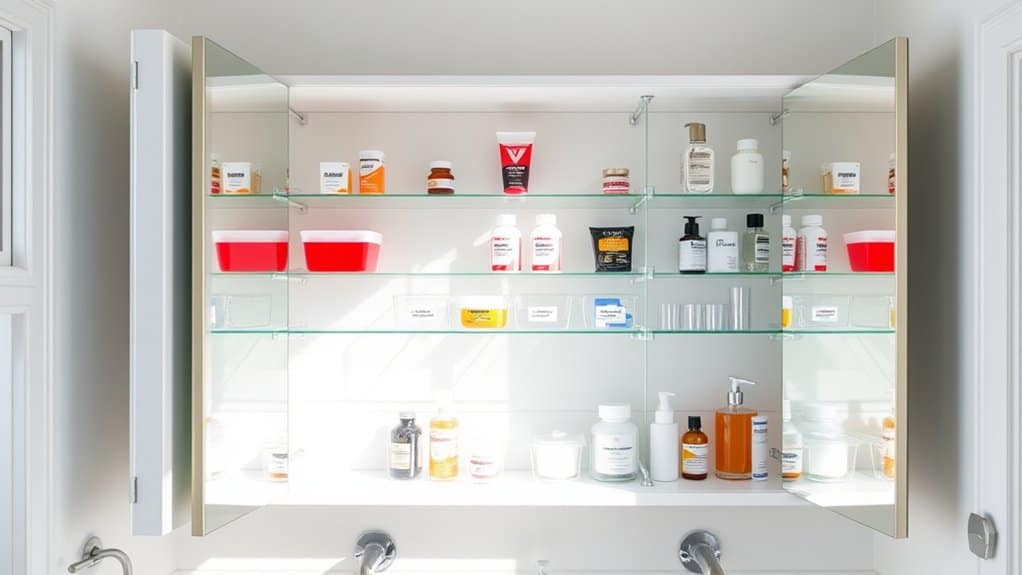
An organized medicine cabinet is essential for maintaining a safe and efficient home healthcare system. When medications and personal care items are properly sorted into designated zones, you can quickly locate what you need during both daily routines and emergencies, potentially preventing dangerous mix-ups or expired medication usage.
Creating clear storage zones transforms a cluttered medicine cabinet into an intuitive, functional space where every item has its proper place. This systematic approach not only saves time but also helps track inventory levels and expiration dates while keeping similar items grouped together for logical access.
Required Items:
- Small plastic bins or organizers
- Label maker or labels
- Clear storage containers
- Shelf liner
- Measuring tape
- Cleaning supplies
- Small risers or drawer organizers
- Clear plastic bags
Start by completely emptying the medicine cabinet and measuring the available space. Divide items into distinct categories: daily medications, first aid supplies, personal care items, and seasonal medications.
Install shelf liner and position small risers toward the back of each shelf to improve visibility. Create primary zones based on frequency of use, placing daily items at eye level, emergency supplies in an easily accessible spot, and less frequently used items on lower or upper shelves.
Assign each zone a specific purpose and maintain clear boundaries between different categories. Place daily medications and vitamins in one section, first aid supplies in another, and personal care items in a third.
Use clear containers or bins within each zone to prevent items from mixing and to maintain organization. Label each zone clearly to ensure all family members can maintain the system.
Consider implementing a quarterly review system to maintain your organized zones. Check expiration dates, restock depleted items, and reassess if the current zone arrangement still serves your needs effectively.
Store items in clear containers whenever possible to easily monitor supply levels, and keep a small notepad in the cabinet to track when medications need replacement.
Install Proper Storage Solutions
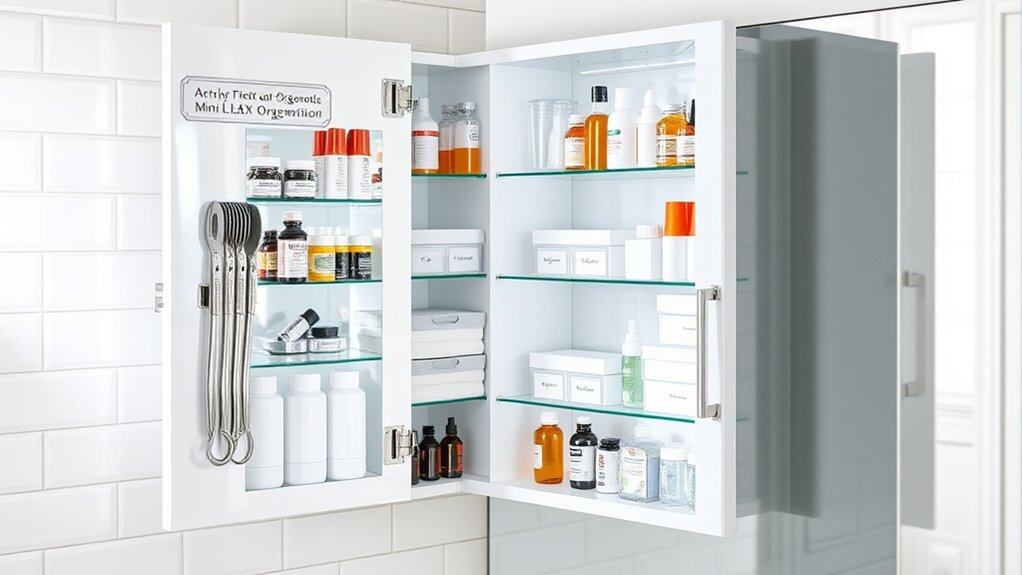
A well-organized medicine cabinet is essential for maintaining easy access to medications and personal care items while ensuring safety and efficiency. Proper storage solutions transform a cluttered cabinet into a functional space where items are easily visible, accessible, and protected from moisture and temperature fluctuations.
Installing the right storage solutions not only maximizes the limited space in a typical medicine cabinet but also helps maintain organization long-term. These systems create designated spots for different categories of items, preventing the common problem of items getting lost in the back of shelves or expired medications being forgotten.
Required Items:
- Clear acrylic organizers
- Small plastic bins
- Drawer dividers
- Adhesive shelf liners
- Label maker
- Measuring tape
- Level
- Screwdriver
- Command hooks or adhesive strips
- Small lazy Susan turntable
- Magnetic strips
Start by measuring your cabinet’s interior dimensions and sketching a plan for optimal storage placement. Remove everything from the cabinet and clean thoroughly. Install shelf liners to protect surfaces and provide grip.
Mount magnetic strips on the inside of cabinet doors for metal items like tweezers and nail clippers. Position clear acrylic organizers on shelves, ensuring proper spacing for frequently used items. Install small lazy Susan turntables in corner spaces for better access to small bottles and containers. Secure additional hooks or adhesive strips on doors for items like hair accessories or dental products.
Create zones within the cabinet using drawer dividers and small bins. Designate specific areas for categories such as first aid supplies, daily medications, personal care items, and dental products. Label each zone clearly to maintain organization and ensure items return to their proper places after use.
To maximize your newly installed storage solutions, regularly review and adjust the arrangement based on usage patterns. Consider installing battery-operated LED lights for better visibility, and implement a quarterly check of storage solutions to ensure they remain secure and functional.
Remember to leave some empty space for future items and seasonal medications.
Label Everything Clearly
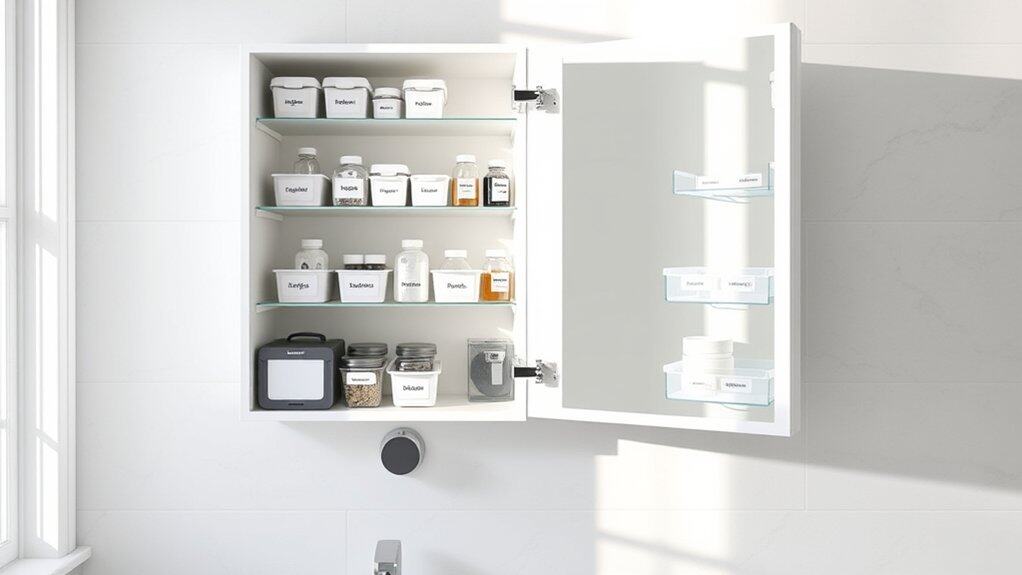
Clear labeling in your medicine cabinet is crucial for safety and efficiency. When medications and supplies are properly labeled, you can quickly locate items in emergencies and prevent potentially dangerous mix-ups between similar-looking containers. This organizational step is particularly important for households with children, elderly members, or multiple medication users.
Proper labeling also helps track expiration dates, dosage instructions, and specific storage requirements for various medications and health supplies. This system reduces waste by preventing duplicate purchases and ensures you’re aware of items that need replacement before they run out.
Required Items:
- Label maker or permanent marker
- Blank adhesive labels
- Clear tape
- Small containers or bins
- Writing pad
- Reading glasses (if needed)
- Storage pouches
- Plastic bags for grouping items
Start by removing all items from your medicine cabinet and sorting them into categories. Create clear, legible labels for each container or shelf space, using waterproof materials that won’t fade or peel. Include essential information such as the item name, expiration date, and any special instructions.
For prescription medications, ensure the original pharmacy label remains visible and add any additional relevant information on a separate label. When labeling containers or bins, use large, easy-to-read fonts and consider color-coding for different categories (first aid, daily medications, seasonal items).
Position labels on the front and top of containers for visibility from multiple angles. For items that require special storage conditions, include relevant symbols or notes (such as “Keep Refrigerated” or “Store in Dark Place”).
Additional Tips: Create a master inventory list with expiration dates and tape it inside the cabinet door. Use symbols or icons alongside text for quick recognition, especially in low-light conditions.
Review and update labels quarterly, removing outdated information and replacing any labels that have become worn or difficult to read. Consider adding emergency contact information and basic first aid instructions on the inside of the cabinet door for quick reference.
Keep Emergency Items Easily Accessible
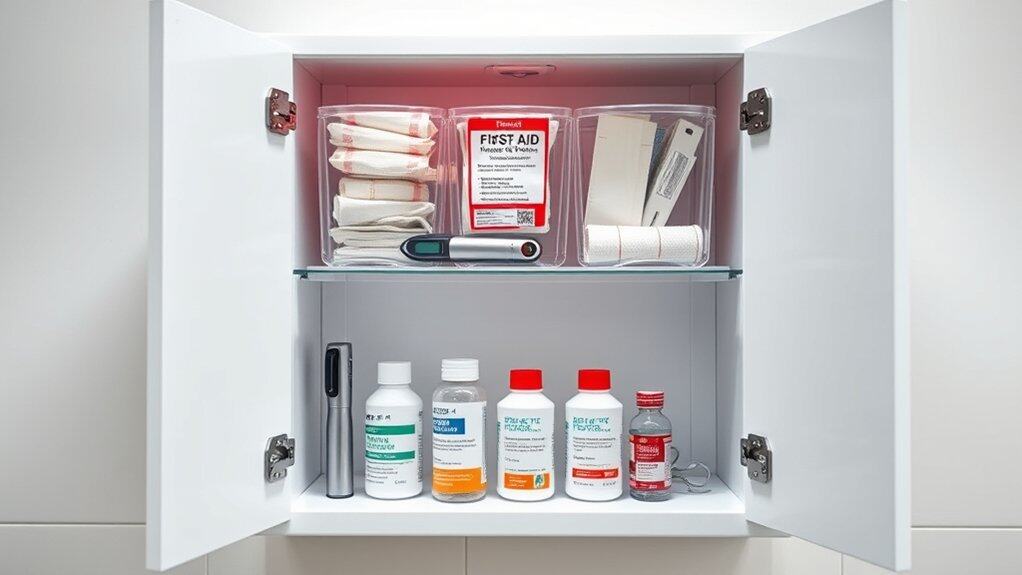
In any medical emergency, every second counts. Having emergency items readily accessible in your medicine cabinet can make a critical difference when urgent situations arise. Proper organization of these essential items ensures that you or anyone in your household can quickly locate and use them when needed most.
Creating a dedicated emergency section in your medicine cabinet not only saves precious time during critical moments but also helps maintain the integrity of these important items. Regular visibility of emergency supplies also makes it easier to check expiration dates and replace items as needed, ensuring you’re always prepared for unexpected situations.
Required Items:
- Clear plastic bins or containers
- Label maker or waterproof labels
- First aid supplies
- Emergency medications
- Bandages and gauze
- Antiseptic wipes
- Medical tape
- Emergency contact list
- Small flashlight
- Medical scissors
- Digital thermometer
Start by designating the most accessible shelf or section of your medicine cabinet specifically for emergency items. Group similar items together in clear containers – one for wound care, another for emergency medications, and a third for diagnostic tools like thermometers.
Position these containers at eye level or slightly below for easy reach. Create a clear labeling system that’s visible even in low light conditions, and attach an emergency contact list to the inside of the cabinet door.
The organization should follow a logical flow: immediate-use items like bandages and antiseptic wipes in front, followed by secondary items like gauze and medical tape behind them. Keep emergency medications in a separate, clearly marked container to prevent confusion with regular medications.
Ensure all items remain in their original packaging when possible, with clear expiration dates visible.
Additional tip: Create a basic inventory list of emergency supplies and tape it inside the cabinet door. Review and update this list quarterly, marking expiration dates and replacement needs.
Consider keeping a small battery-powered light attached to the cabinet to ensure visibility during power outages, and maintain a small notepad and pen nearby to record any important medical information during emergencies.
Implement a Regular Maintenance Schedule
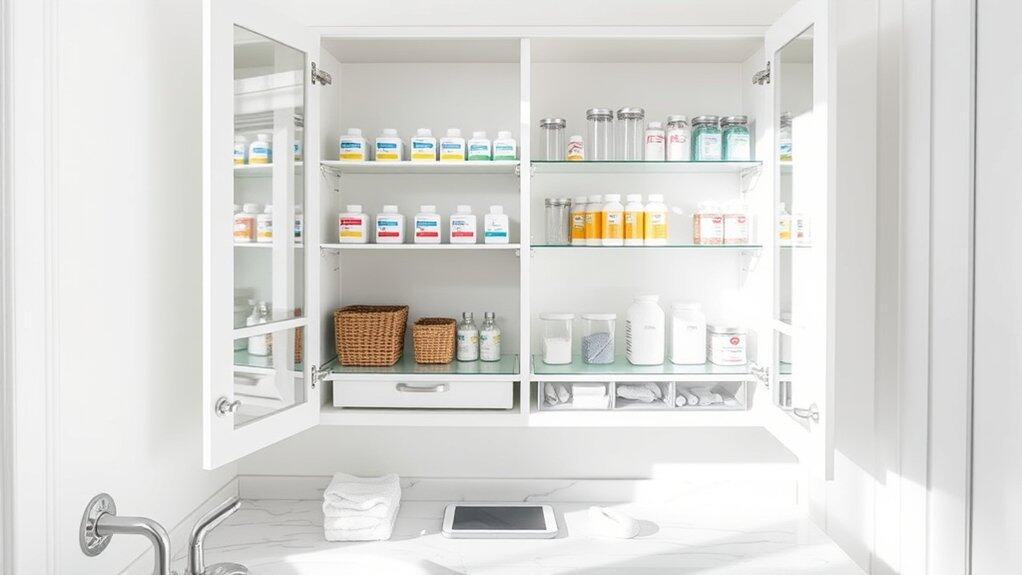
Regular maintenance of your medicine cabinet is crucial for both safety and efficiency. Expired medications, empty containers, and disorganized items can create confusion and potentially dangerous situations, especially during medical emergencies when quick access to specific items is essential.
A well-maintained medicine cabinet not only ensures that all medications and first-aid supplies are current and readily available but also helps track inventory levels and usage patterns. This systematic approach to organization can save money by preventing duplicate purchases and protect family health by ensuring medications remain effective.
Required Items:
- Calendar or digital reminder system
- Cleaning supplies
- Storage containers
- Label maker or labels
- Notebook for inventory
- Disposal bags
- Gloves
- Disinfectant wipes
The maintenance schedule should be implemented on three distinct timeframes. Monthly checks focus on basic organization, wiping down shelves, and checking inventory levels of frequently used items.
Quarterly reviews involve a deeper assessment of expiration dates, reorganizing categories, and updating the inventory list. Annual maintenance requires a complete cabinet emptying, thorough cleaning, disposal of expired items, and comprehensive reorganization of all contents.
During each maintenance session, remove all items from the affected area and sort them into categories: medications, first-aid supplies, daily care items, and seasonal products. Check expiration dates, condition of packaging, and current necessity of each item.
Clean the cabinet surfaces thoroughly before returning items to their designated spaces. Update your inventory list and note items requiring replacement.
Success Tip: Create a digital or physical tracking system that aligns with your schedule. Set automatic reminders for maintenance days, keep a running list of items that need replacement, and maintain a log of medication expiration dates.
Consider implementing a color-coding system for different categories or family members, and always document any changes in medication storage locations to ensure all household members can locate items quickly when needed.
Choose the Right Storage Containers
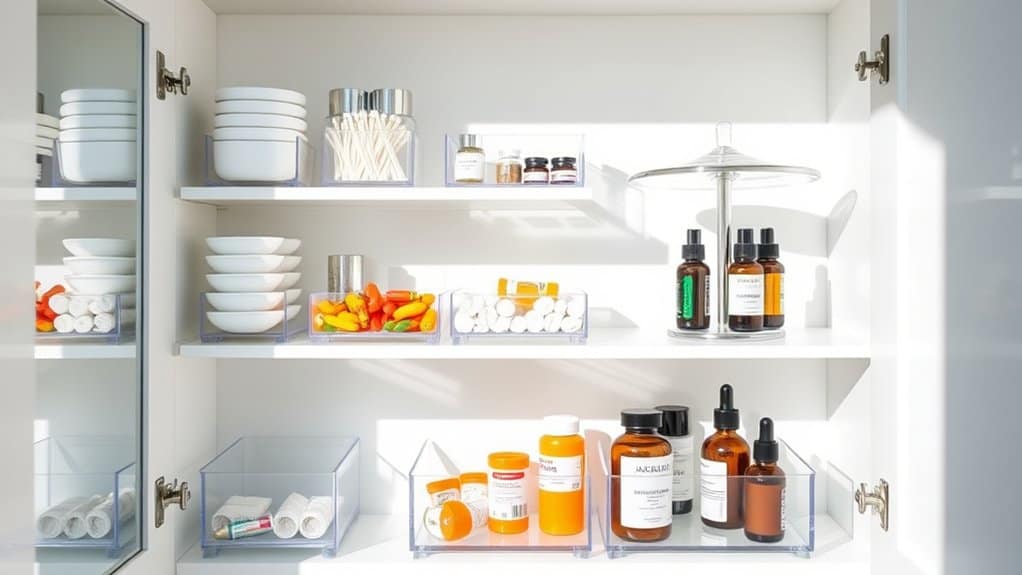
Selecting appropriate storage containers for your medicine cabinet is crucial for maintaining order and ensuring easy access to essential items. Well-chosen containers prevent chaos, protect medications from moisture, and maximize the limited space typically available in medicine cabinets.
Proper storage containers not only keep items organized but also help maintain the efficacy of medications and prevent cross-contamination between different products. They create clear boundaries between categories of items and make it easier to quickly locate what you need, especially in emergency situations.
Required Items:
- Clear plastic containers with lids
- Small drawer organizers
- Stackable bins
- Label maker or labels
- Measuring tape
- Cotton-lined containers for vitamins
- Medicine bottle organizers
- Shelf liner
- Small lazy susans
- Magnetic containers
Select containers that fit your cabinet’s dimensions, measuring both height and depth to ensure proper fit. Group similar items together and choose containers accordingly – shallow ones for small items like bandages, deeper ones for tall bottles, and specialized medical storage containers for temperature-sensitive medications.
Consider using stackable containers to maximize vertical space, and opt for clear containers whenever possible to easily identify contents. Install shelf liners before placing containers to prevent sliding and protect surfaces.
Additional organizing success tips: Regularly audit your storage containers for functionality and replace any that show signs of wear or damage. Consider keeping frequently-used items in easily accessible containers at eye level, while storing rarely-used items in higher or lower spaces.
Always ensure child-proof containers for medications when necessary, and avoid storing temperature-sensitive items in containers that might trap heat or moisture.

